Samsung Galaxy W I8150 review: S Plus Lite
S Plus Lite
User Interface: Gingerbread and TouchWiz 4.0
The Samsung Galaxy W runs Gingerbread version 2.3.5 and, with the most recent TouchWiz launcher on board, you’ll be looking at a Galaxy S II like experience on a smaller budget.
We’ve prepared a video of the device in action. Check it out below.
The lockscreen holds no surprises. It can be swiped away in any direction. The cool feature where missed events (messages, calls etc) get their own unlock patterns is still here too.

The lockscreen can be removed by swiping in any direction
The homescreen accommodates tons of widgets with lots of functionality. You can have up to 7 homescreens. A pinch zoom brings you to an aggregate view of all homescreen panes, which can be edited: rearranged, deleted or added.
Widgets, shortcuts or folders are pulled onto the homescreen from a drawer that appears at the bottom of the screen once you enter edit mode (press and hold on an empty spot or do Menu > Add).




The Galaxy W's homescreen • Editing the homescreen
The numbered dots that identify the homescreen panels serve as a scroll bar too. A press and hold on the dots lets you scroll sideways through the resized images of the available homescreen panes in one short go rather than with several swipes.

Scrolling between homescreens looks great
The app launcher is very similar to the homescreen - you can create folders to go with your shortcuts and you can add, remove and rearrange pages just like you would homescreens.
You can choose List view instead of the regular grid view if you prefer.




The app launcher • Creating a new folder • Rearranging pages in the app launcher • List view
In typical TouchWiz fashion, there are four shortcuts docked at the bottom of the screen that are visible both on the homescreen and in the app launcher. You can swap the first three with different ones (by default the shortcuts are Phone, Contacts, Messaging), the fourth one being locked. It's the app drawer/home shortcut so it makes sense to always keep it in the same place.
The notification area has been slightly remodeled in TouchWiz 4.0, but there aren’t any major changes to the functionality there.
With the Samsung Galaxy W I8150 you get a standard Android task switcher but with one modification - it has a button to launch a task manager.
The custom task manager, which Samsung have preinstalled, offers a lot of functionality. It also comes with a handy widget which shows you the number of active applications right on your homescreen.



The task manager and its widget
Most of the time, Android does really well when it comes to managing apps by itself (in fact, some claim that using a task manager is detrimental to the performance of a phone), so you would only need the task manager to occasionally kill a buggy app.
Synthetic benchmarks
The fast single-core CPU manages to hold its own when it comes to single-threaded benchmarks like BenchmarkPi. Here the HTC Sensation XL and XE lead the Galaxy W a bit, but they are clocked 100MHz higher. The Galaxy S II uses a newer architecture than the others and beats them despite its lower clock speed.
Running Linpack in single-threaded mode sees the Galaxy W and the Sensation XL almost equal. The Sensation XE exhibits some software issues that get in the way of proper multithreading in this test.
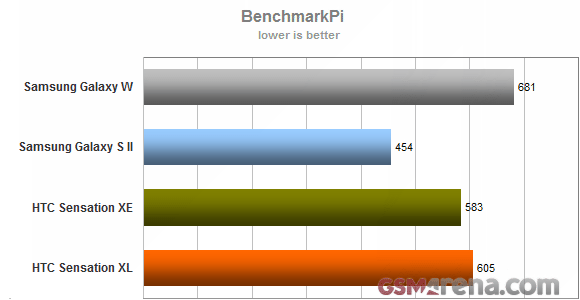
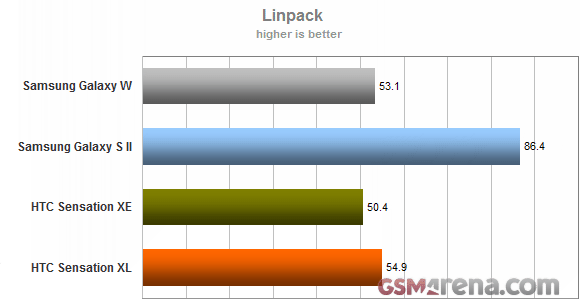
In the 3D graphics test, the Samsung Galaxy W performed surprisingly well. It left both HTCs in the dust (the XL has the same Adreno 205 GPU and the same screen resolution, so it beats us why it's almost three times slower). The Galaxy W even manages to get close to its high-end counterpart, the Galaxy S II, which has a beefy Mali-400MP GPU.
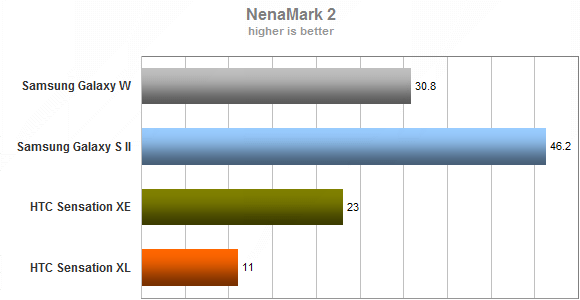
In JavaScript performance, the Galaxy W is comparable to the HTC Sensation XE, if not slightly better. The XE really doesn’t benchmark well. The Sensation XL, however, comes ahead of the Samsung Galaxy W by a comfortable margin - that's the effect of a finely tuned JavaScript engine by HTC.
The HTML5+JavaScript benchmark, BrowserMark, puts the HTCs well in the lead - again, the effect of good software optimization. The Galaxy W and Galaxy S II run identical software, so the difference we're seeing is due to differences in CPU performance.
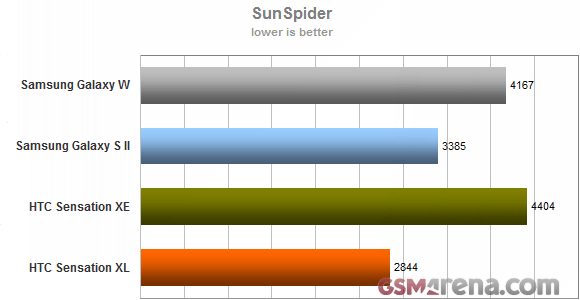
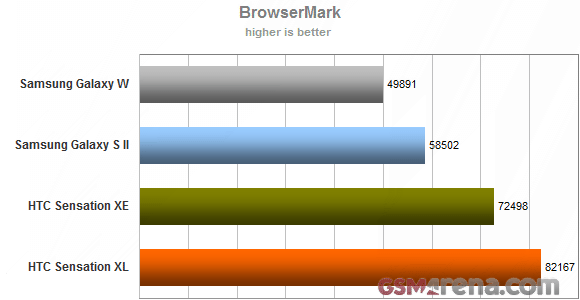
Reader comments
- Anonymous
- 29 Dec 2013
- tue
give me networ speed
- vasantharaja
- 05 Dec 2012
- 3xJ
i think next week purchace this currect or not plz comment wi80150
- AnonD-63234
- 25 Nov 2012
- uEB
i've just read this.. hahaha. well what kind of browsing? i mean, if you load a heavy page like facebook and show all contents like web browser not mobile, yes it would cause battery to hot, but i think not that hot.. i use this device for games exam...
